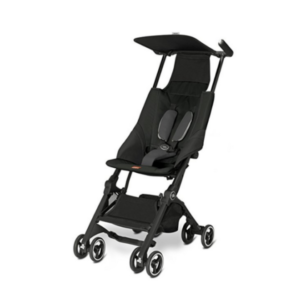Bed wetting or enuresis is the occurrence of intermittent episodes of wetting the bed while asleep by children over the age of five. Bed wetting can negatively impact a child’s self-esteem and hinder the ability of the child to participate in social events like camps and sleep-overs. We have a well-researched guide on the best bed wetting alarms in the market for you.
Factors to Consider When Choosing the Best Bed Wetting Alarms in the Market
Factors To Consider
Best Bed Wetting Alarms
|
Best Bed wetting alarms in the Market
1.Chummie Premium Bedwetting Alarm with 8 Tones
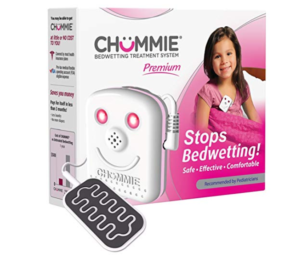
This is one of the best bed wetting alarms in the market, This is the perfect choice for deep sleepers and the perfect bedwetting alarm for training to stop bed wetting permanently. As one of the best bed wetting alarms for kids this Chummie Premium Bedwetting Alarm has an Innovative One Drop Detection Sensor, Free smartphone App and works as one of the best safe and effective bedwetting solution.
|
Chummie Premium Bedwetting Alarm with 8 Tones
|
Features
|
2.TheraPee – The world’s #1 Bedwetting Solution
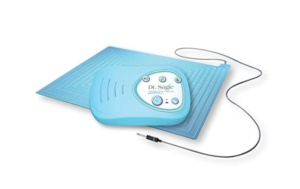
Just as the name suggests this is one of the best bed wetting alarms in the market, it has one of the best and advanced bed pad and alarm systems and is very engaging and interactive. Its suitable;e for children between 4 and 18 years.
|
TheraPee – The world’s #1 Bedwetting Solution
|
Features
|
3.DryEasy Bedwetting Alarm with Volume Control, 6 Selectable Sounds and Vibration
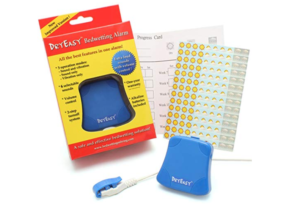
DryEasy bedwetting alarm is one of the best bet wetting alarms in the market, its a comprehensive product equipped with a wid range of features which make it one of the best. it has an alarm that is specially made to wake up evn heavy and deep sleepers, With 6 different sounds one cannot get used to a specific sound.ToggleSmart is easily and securely attached to underpants while the sensor is very reliable in triggering the alarmeverytim as soon as bedwetting occurs. Cleaning and dryoing is very easy especially due to the open cover design.This is the most vrsatile bed wetting alarm in the market.
|
DryEasy Bedwetting Alarm with Volume Control, 6 Selectable Sounds, and Vibration
|
Features
|
4.Wet-Stop 3 Bedwetting Alarm (Green) 6 Alarms & Vibration, Enuresis Alarm
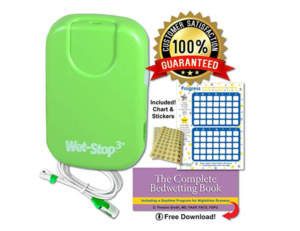
This is a high quality and low cost bed wetting alarm, it comes with a set of goodies: sticker reward system, A Complete Bedwetting Book ,instructions in 6 languages and a reward chart. It has a sound and a vibrating alarm with several sounds so that the child doesn’t get used to a particular sound. Easy to wear and use wearable unit sensor.
|
DryEasy Bedwetting Alarm with Volume Control, 6 Selectable Sounds, and Vibration
|
Features
|
Best Bed Wetting Alarms for Kids
Choosing the best bed wetting alarms for kids. Here are some factors to consider.
- Vibration and Sound- the best bed wetting alarms should have a variety of sounds and vibration so that the child doesn’t get used to a particular sound. The tones should also be loud and not frightening.
- Ease of use- the best bed wetting alarms for kids should be easy to use, easy to programme and easy to wear.
- Effective Sensors
- Should be Portable
|
Best Bed Wetting Alarms for Kids
|
|
The main causes of bedwetting are not complete, but it is mainly though that it arises from different factors including the production of too much urine, reduced production of vasopressin hormone and over activity of the vasopressin muscle.
Some factors are also known to make bedwetting worse or more likely as they alter the balance in children at night. They include:
- When a child is stressed. Bed wetting may arise if a child happens to be stressed. For example due to bullying at school, illness, the arrival of a new child or abuse.
- Drinking and eating food that caffeine including tea, coffee, and chocolate. Which increase the amount of urine made by the kidneys.
- Constipation. Large stools in the rectum press the back passage which is the rectum irritating the back of the bladder. Most children with constipation problem are likely to be bedwetters.
- Children with attention deficit hyperactivity disorder (ADHD) have a higher risk of being bed wetters.
A bed wetting alarm is an option to treat children who are wetting the bed at night. Using a bed wetting alarm reduces bedwetting in about two-thirds of children during treatment, and about half of the children remain dry after stopping using them. Although many young children wet their beds, most stop by the time they are 4 or 5. Bed wetting that persists can lead to embarrassments and teasing by peers. If your child id 6 or 7 and still wets the bed, consider talking to a doctor.
Features of bed wetting alarms.
If you have a child with bedwetting problems and are thinking of purchasing a bedwetting alarm, you should have some considerations on the features that the alarm has. Below are some key features of bedwetting alarms.
- Sound and vibrations. This is an essential feature of any bed wetting alarm system. An alarm with sound is a must have, and the vibration makes it easier for the child to wake up as it gives a tickle feeling. The alarm should also have different sounds to avoid auditory accommodation where the child gets used to only one sound. The alarm should also not be too loud to cause auditory problems for your child.
- Types of the sensor. The sensor is likely to touch your child’s skin during treatment. It is important to know the material used to make the sensor as some metals may cause allergies or sensitivity to the skin. Also, check if the material will rust over time.
- Sensor attachment. The alarm sensor should be attached well to the child’s underwear. This is important as the sensor will not fall off when the child tosses around at night. The material of the clip should also be skin friendly to avoid harming the child. Some attachment areas will sense when it the alarm is not attached well to the underwear.
- Alarm A reliable alarm should be able to differentiate sweat and urine. Sweat is likely to trigger an alarm. The alarm should not go off when any other liquid touches it. This may cause disruptions and the user to get tired of waking up because of the wrong reasons.
- Ease of use. The child using the alarm should be able to use the alarm hence its ease of use is an important consideration.
- Easy to clean. You should get an alarm that is easy to clean to avoid frustrations. Also, get an alarm that will not tear up when cleaned up. Metal sensors should be avoided as they rust after getting to contact with water
What to look for in a bed wetting alarm
Getting the best alarm for your child may be a difficult task. Here are some of the important guidelines you should consider;
- How will the alarm be switched or turned off?
With wireless alarms, the sound comes from across the room. In this case, the child must get out of the bed to switch it off. In wearable alarms, however, the alarm is located on the shoulder of the pajama top. The child has to disconnect the sensor from the underwear and then push the reset button on the shoulder. You should ensure the bed wetting alarm you get is easy to switch off for your child.
- Where is the alarm sensor placed?
It is better to have a small comfortable sensor attached securely to the child’s close-fitting underwear or in specially designed briefs. Bulky sensors or large mats will not be as comfortable for your child.
- How high is the volume?
An effective alarm system should have its volume loud enough for the parents to hear from their room to help the child get up. A wireless alarm should have a volume control so as not to scare the child. This type of alarm, however, should be accompanied by a monitor for the parent’s room
Factors to consider when choosing a bed wetting alarm
Choosing a bed wetting alarm for your child is a crucial aspect of beginning the treatment. With the different variety of alarms in the market, getting perfect on for your child might be difficult. Here are some factors you should put into consideration before purchasing a bed wetting alarm.
- Determine the cause: identifying the cause of bed wetting is crucial as the bed wetting alarm may not treat some issues like medical issues or emotional stress.
- Type of sleeper. Identify the type of sleeper tour child is. Sometimes, a basic alarm is all you will need to stop your child from bed wetting. However, if a child is a deep sleeper, an alarm that is not loud enough will not only be a waste of time but also resources.
- Type of sensor. The sensor is a crucial part of the alarm unit. You should make sure it is non-corrosive, metal-free (many children are sensitive to sensors that use metal clips), hypo allergic, reusable, soft, effective, and easy-to-clean.
- Alarm features. Bed wetting alarms must have sound and vibration for optimum results. The more the sounds available, the easier it is for your child to wake up. One sound can easily lead to auditory accommodation which will make the treatment unsuccessful. The sound should also not be too loud to cause auditory problems.
- Comfort during sleep should be the top priority for a parent. Wired alarms that are fastened on the child should be made from skin friendly material. Safety pins can be a good idea for fastening the sensor but should be used with care. A bell and pad alarm should have a comfortable sleeping pad for utmost comfort
- Sensor attachment. The sensor should always be attached firmly to the child’s underwear to prevent it from falling off at night. Metal snap closures are usually uncomfortable for the child and may cause resistance to treatment. An alarm that senses detachment will also be a good one.
- The market now offers small and light-weight alarms. A small compact alarm unit is easier to carry around during traveling and sleepovers.
- Cost. The cost of bed wetting alarms will vary depending on the features and benefits. An expensive alarm is more likely to have more features and benefits. This will also mean better results.
- Normally, the batteries are the hidden costs in bed wetting alarms. Most alarms, however, come with their recommended batteries and unless there is a need to replace them.
- Warranty and Support. This is important incase the alarm starts malfunctioning after a short while. The buyer should always enquire about this.
|
Best Baby Strollers
|
|
Different types of bedwetting alarms
Bedwetting alarms have recently proven to be more effective in treatment than prescription medication. This is because they work with the brain of the child. The market offers a different model, styles, and types which can be classified into three categories as discussed below. Every parent must examine the type, benefits, and features of alarm to get the best for their child.
- Wired Bedwetting Alarms: wired alarms consist of two-part, the alarm unit, and the sensor, a wire connects the to parts. The sensor is connected to the alarm t through a wire that runs below the child’s pajama top, or it can be clipped to the shoulder of the pajama. Wired alarms respond quickly to urine and alert the parent and child to wake up.
- Bell and Pad Bedwetting Alarms: This type of alarm does not require an alarm unit to be connected to the bed wetter. A moisture responsive mat is placed on the bed where the child sleeps. Such alarm provides maximum comfort for the child. However, the bell and pad alarm take a while to detect urine.
- Wireless Bedwetting Alarms: These type of alarms are meant for people who do not love having wires. This alarm does not use the sensor that is prevalent in wired alarms. It makes use of a micro wire that is built in a machine washable underwear and a transmitter that connects to the pants. The alarm is silent. Hence only the wearer can hear it when it goes off.
These are the different types of alarm in the market that will help your child achieve complete dryness. When getting an alarm to make sure you also get your child preference, his or her safety, the reliability, quality of the alarm and the alarms efficiency.
How bed wetting alarms work
Bed wetting alarms are among the most effective and safest bed wetting treatments. With bed wetting alarms, a special moisture sensor placed in the child’s pajamas triggers a bell or buzzers to go off at the start of urination. The three types of bed wetting alarms are designed to work in different ways. An alarm is designed to awaken the child so that he or she can go to the bathroom and finish urinating. Normally, in the first weeks, the parent has the responsibility of waking the child up as the child is not used to it. If the alarm is used on a daily basis for about four to six weeks, your child is likely to start waking up on her own and go to the bathroom or hold the urine until morning. After frequent dry night, like three, try withdrawing the alarm to see if the child will wake up without the alarm. If your child starts bedwetting again, start the process again
- The wired bed wetting alarms. This alarms have two units: the alarm unit and the sensor. The sensor is placed outside on the outside of the underwear and is secured by a clip or another underwear. When the child urinates, the sensor triggers the alarm to go off. This alarm has both vibrations and sound for best efficiency. The alarm will alert the child to wake up and go to the restroom to finish urinating. However, parents are concerned about their children being attached to wires and may freak out while using this type of bed wetting alarms.
- The bell and pad alarms. The child sleeps on moisture receptive mat or pad that is connected to the alarm unit placed on the bed side. Instead of an outside sensor, the mat will detect the urine and trigger The alarm to wake the child and finish urinating in the bathroom.
- Wireless alarms. A wireless bedwetting alarm does not use the sensor that is more prevalent in the wired alarms. However, wireless bedwetting alarms use a micro-wire that is built into machine-washable underwear and a tiny transmitter that connects to the pants. The alarm is silent, and only the child is wearing it knows it has gone off. This type of alarms may also not be attractive as the child may be afraid of going to the toilet alone on the first days hence making this method not effective. This type may also be ineffective for heavy sleepers.
What happens after the alarm is activated?
- The alarm sound will be triggered when the first drop of urine gets on the sensor.
- Some terms will have the sound and a red light that will aid in waking up the child.
- On the initial days of treatment, after the alarm goes off the parent will go and help the child get up and go to the bathroom. This task should be left after some time.
- The child should wake up and empty his bladder in the bathroom and not in bed.
- The child should clean up and if the child is still new to the system the parent should assist him/her.
- The alarm should never be immersed in water. The sensor should be cleaned after being disconnected from the alarm. It can be wiped with a dump cloth and dried properly.
Resetting the alarm will be a simple process. You only have to put the sensor plug to the alarm case. However, different alarms sound differently and hence it is important to read the user manual. Some alarms will have a beep sound if connected wrongly.
Cleaning and storing bed wetting alarms.
Cleaning the bed wetting kit is a crucial part of maintaining hygiene is very important for your child. As mentioned before, you should never immerse the alarm in water. Below are some of the essential dos and don’ts in cleaning the bed wetting alarms?
- It is important to ensure the sensor plug, and the cord is all disconnected from the alarm case before
- A dumb soapy cloth can be used for cleaning.
- Harsh chemicals should be avoided when cleaning the sensor or the cord.
- The sensor or the cord should not be put in hot water.
- The sensor and cord should not be sterilized.
Storing the alarm is also a very important thing. The bed wetting alarm must always be disconnected from the alarm case when the alarm is not in use. This will preserve battery life. Most have recyclable packaging supplied with the bed wetting alarm. This has been designed to store the alarm case, progress diary, the sensor cord, and the user instructions. It is important to keep the packaging after purchase as it can be used as a storage place for the alarm.
What will work for sound sleepers
Many parents and guardians looking for solutions to their children’s bed wetting normally assume that the alarms will not work for children who are sound sleepers. This however is not true as bed wetting alarms can be effective even for the soundest of sleepers. For this children, however, parents have the major role of waking the child up when the alarm goes off. As long as the alarm is loud enough for the parent to hear, they can assist their child if they had not responded initially. Since the wearable alarms all sound at 80 decibels and make a variety of noises, they can be very useful for sound sleepers. Also, wireless alarms can be a good option as they sound even louder.
Once the parent hears of the alarm, they should respond quickly. If the child happens to wake up and sit down or is making movements, it is up to the parent to remind the child what to do next, go to the bathroom. In case the child is still completely asleep, it will be important for the parent to wake the child themselves. Some bed wetting alarms come with an additional unique unit for the parent’s room. This is extremely important for parent’s rooms who are not near the children’s room. They are mostly wireless alarms.
Advantages of using bed wetting alarms
The greatest advantage of bedwetting alarm treatment is that the child will get used to waking up on their own after some time. As soon as the parent gets used to waking up the child, the child will be able to know the sound of the alarm on his/her own and wake up and feel the bladder being full. Once the child gets used to waking up on his own to use the bathroom, the bed wetting habit is more likely to stop.
The use of alarm for bed wetting treatment helps the child to know how to take care of the bed incase of bed wetting incidents. After some time, train the child to remove the wet underwear and beddings. When she gets used to waking up on her own, she will not rely on you to do those for her as she will have already known how to clean up. Giving rewards for these tasks will greatly motivate the child to perform these tasks
Tips for success when using the bedwetting alarms
Success when using these alarms is likely when the child is more motivated by the parents. Motivation is boosted when you let your child be responsible for the alarm and cleaning off and praising your child for signs of progress. Completely dry nights will not occur straight away as it takes the time to gradually condition your child’s and their bladder.
If there is no success at first, you should not punish your child. However, if there is no success from your child after four weeks, it is unlikely that the alarm will work, and you are advised to seek medical advice. During the treatment, parents are advised always to communicate with the advisor on the progress of the child. This will make it possible to have adjustments to the program. Any arising problems can also be discussed. Normally, alarms are used two weeks after dry nights before the alarm can be withdrawn. If the child starts bed wetting in the future, using the alarm will stop the habit. For higher success possibilities, the alarm can be used with other treatments like desmopressin or with rewards. Alarms should be introduced when all other treatments do not work.
Conclusion.
Bed wetting alarms have proven to be an effective way to prevent bed wetting. Every parent is encouraged to get one if their child still wets the bed even after turning five years. Bed wetting alarms work on the same psychological principle as behavioral conditions. After using an alarm for some time, the child’s brain gets used to waking up and urinating. After some time, the child will be able to wake up without the alarm going off. Bed wetting alarms are the best option for bed wetting treatment



